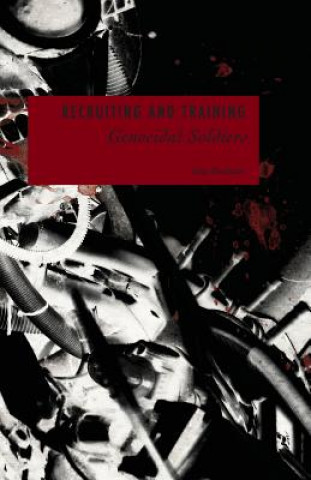
Kód: 11613964
Recruiting and Training Genocidal Soldiers
Autor Gregory Procknow, Greg Procknow
Human resource development (HRD) has contributed nothing to the historical archaeology of genocide. Furthermore, HRD theory has never been used by history educationists, social scientists, or comparative genocide researchers to re ... celý popis
- Jazyk:
 Angličtina
Angličtina - Väzba: Brožovaná
- Počet strán: 224
Nakladateľ: Francis & Bernard, 2014
- Viac informácií o knihe

Mohlo by sa vám tiež páčiť
-

To All Airline Passengers
12.77 € -4 % -

Trail Hand
38.03 € -

Neues Museum Berlin. Architectural Guide
8.78 € -10 % -

Die Urheberverguetung im franzoesischen Urheberrechtsgesetz- (Loi sur la propriete litteraire et artistique)
62.47 € -

Die Qualität von Abschlussprüfungen im Kontext der Haftung, Größe und Spezialisierung von Prüfungsgesellschaften
67.18 €
Darčekový poukaz: Radosť zaručená
- Darujte poukaz v ľubovoľnej hodnote, a my sa postaráme o zvyšok.
- Poukaz sa vzťahuje na všetky produkty v našej ponuke.
- Elektronický poukaz si vytlačíte z e-mailu a môžete ho ihneď darovať.
- Platnosť poukazu je 12 mesiacov od dátumu vystavenia.
Viac informácií o knihe Recruiting and Training Genocidal Soldiers
Nákupom získate 91 bodov
 Anotácia knihy
Anotácia knihy
Human resource development (HRD) has contributed nothing to the historical archaeology of genocide. Furthermore, HRD theory has never been used by history educationists, social scientists, or comparative genocide researchers to reorganize and review the historical record relating to genocidal curriculums through an HRD lens to make better sense of the madness that genocides perpetrate. Chapter One discusses human resource development in Democratic Kampuchea, 1975-1979, and provides a deconstruction of the dearth of literature and research that has framed education and learning in Democratic Kampuchea (DK). Historical analysis of Democratic Kampuchea asserted that education under the Khmer Rouge was unorganized, inconsistent, and without planning. The deconstruction of the historical record called these views into question. In Chapter Two, Nadler and Nadler's (1994) critical events model (CEM) is applied to the Serbian Volunteer Guard (SDG). The model will be utilized to thematize the historical record pertaining to learning of the SDG under the eight-step, programmatic CEM approach to program design. The chapter shows how HRD or adult educational models can be used to thematize or reorganize historical data. In Chapter Three, a comparative analysis is undertaken of two perpetrators of Rwanda's 1994 genocide: Interahamwe and civilian defense (CD). The historical record confuses these two genocidal perpetrators and likens the actions of civilian defense to Interahamwe. This chapter sufficiently demonstrates how HRD as a field can work to hold perpetrators of crimes against humanity and genocide culpable for their actions through proper identification. Chapter Four applies the HRD lens to pedagogical political curriculums contrived for the youth of the Khmer Rouge and the Hitler Youth. A comparative analysis of their political curriculums is contrasted in this chapter. Although the Hitler Youth curriculum was Fascist and racist and the Khmer Rouge zealously Communist and classist, the review of the historical record had shown both political curriculums replete with similarities. Chapter Five characterizes the relationship between the Janjaweed and the Government of Sudan (GOS) during the Darfur genocide. The misconceptions of the performance paradigm of HRD levied by learning paradigm advocates are related to the relationship between these two entities. With this in mind, performance systems theory is then applied to the relationship.
 Parametre knihy
Parametre knihy
36.80 €
- Celý názov: Recruiting and Training Genocidal Soldiers
- Podnázov: Human Resource Development Perspectives on Genocide and Crimes Against Humanity
- Autor: Gregory Procknow, Greg Procknow
- Jazyk:
 Angličtina
Angličtina - Väzba: Brožovaná
- Počet strán: 224
- EAN: 9780986837401
- ISBN: 0986837407
- ID: 11613964
- Nakladateľ: Francis & Bernard
- Hmotnosť: 291 g
- Rozmery: 216 × 140 × 13 mm
- Dátum vydania: 30. September 2014
Obľúbené z iného súdka
-

Dune
13.08 € -

Haunting Adeline
30.77 € -

Berserk Deluxe Volume 2
52.66 € -

White Nights
3.57 € -24 % -

Powerless
12.47 € -4 % -

Atomic Habits
15.94 € -15 % -

Dune Messiah
8.99 € -20 % -

Berserk Deluxe Volume 3
52.76 € -

One Day
12.57 € -13 % -

Berserk Deluxe Volume 1
44.37 € -13 % -

Iron Flame
16.25 € -19 % -

Surrounded by Idiots
10.11 € -16 % -

Harry Potter and the Prisoner of Azkaban (Minalima Edition)
27.81 € -32 % -

Gravity Falls Journal 3
22.08 € -

Heaven Official's Blessing: Tian Guan Ci Fu (Novel) Vol. 1
21.46 € -

The Creative Act
24.02 € -

Dune
9.70 € -19 % -

Hunting Adeline
31.79 € -

A Little Life
17.48 € -

Children of Dune
8.78 € -22 % -

Heaven Official's Blessing: Tian Guan Ci Fu (Novel) Vol. 2
18.81 € -9 % -

Bungo Stray Dogs, Vol. 8 (light novel)
16.05 € -1 % -

Percy Jackson and the Olympians 5 Book Paperback Boxed Set
47.75 € -

Solo Leveling, Vol. 1
21.46 € -

The Prisoner's Throne
11.44 € -4 % -

Court of Thorns and Roses
9.30 € -22 % -

Cry Baby Coloring Book
10.93 € -3 % -

Fourth Wing
16.66 € -16 % -

Icebreaker
9.19 € -18 % -

Berserk Deluxe Volume 6
47.75 € -6 % -

Avatar, the Last Airbender: The Kyoshi Novels (Box Set)
27.50 € -33 % -

The 48 Laws of Power
26.89 € -1 % -

House of Leaves
23.20 € -4 % -

Twisted Lies
9.81 € -24 % -

Dune Messiah
10.01 € -31 % -

No Longer Human
16.97 € -

48 Laws Of Power
22.59 € -5 % -

Twisted Games
9.40 € -22 % -

Caraval Paperback Boxed Set
39.77 € -8 % -

Solo Leveling, Vol. 2
22.39 € -

Open Circuits
34.35 € -16 % -

Berserk Deluxe Volume 5
51.22 € -

Heaven Official's Blessing: Tian Guan Ci Fu (Novel) Vol. 3
19.73 € -5 % -

Berserk Deluxe Volume 4
46.52 € -9 % -

Court of Mist and Fury
9.30 € -20 % -

SOLO LEVELING V08
22.39 € -

English File Upper Intermediate Multipack A (4th)
22.18 € -

CHAINSAW MAN V14
11.24 € -14 % -

Before the Coffee Gets Cold
9.09 € -16 %
Osobný odber Bratislava a 2642 dalších
Copyright ©2008-24 najlacnejsie-knihy.sk Všetky práva vyhradenéSúkromieCookies



 21 miliónov titulov
21 miliónov titulov Vrátenie do mesiaca
Vrátenie do mesiaca 02/210 210 99 (8-15.30h)
02/210 210 99 (8-15.30h)